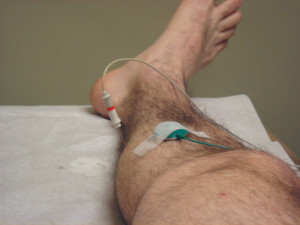Frequently Asked Questions Concerning Electromyogram
Overview:

Needle Electromyography and Nerve Conduction Study; Calf
Photo Credit Xerostomia / Flicker
Electrodiagnostic tests evaluate diseases of the nerves and muscles. Electromyogram (EMG) and Nerve Conduction Studies (NCS) are two components of the same test usually performed together to test whether your muscles and nerves are working correctly. EMG and NCS are tests that measure the electrical activity of the muscles and nerves of the body. The tests can help identify nerve injury or muscle disease such as carpal tunnel syndrome, a pinched spinal nerve (also known as radiculopathy), peripheral neuropathy, etc. The presence or absence of injury can be helpful in determining further treatment.
Why am I being sent for the EMG/NCS test?
You may have various symptoms such as numbness, tingling, pain, weakness, and/or muscle cramping. The test is used to determine the cause or exact location of the nerve injury or muscle disease.
Who performs the test?
This test is typically performed by a specialty-trained physician most often specializing in Physical Medicine and Rehabilitation (PM&R) or Neurology.
How should I prepare for the test?
There is no need to fast before the test. Take all your prescribed medications unless otherwise instructed. Always let your doctor know if you are on any blood thinning medications or have a pacemaker/defibrillator. Do not use any lotions or powders on the area to be tested on the day of the procedure. Dress in loose and comfortable clothes that permit access to the area to be tested or that are easily removed. Testing typically takes 30 to 60 minutes but may be longer depending on the complexity of your symptoms.
What happens during an NCS (nerve conduction study)?
An NCS evaluates the two major nerve groups:
- Sensory nerves (that detect pain, touch, pressure)
- Motor nerves (that move the muscles)
The doctor places sensors on the skin. A small electric pulse, that feels like a small shock, is applied to activate the nerve. Your muscle may twitch. The speed, size, and consistency of the nerve’s response is recorded and analyzed. NCS shocks are mild and do not cause any damage to the nerves.
What happens during an EMG (Electromyography)?
For this part of the exam, a small, thin needle is inserted into several muscles to see if there are any problems. The doctor examines only the muscles necessary to decide what is wrong. The doctor will look at and listen to the electrical signals that travel from the needle to the EMG machine. The doctor then interprets these signals to see if there are any abnormalities.
When will I know the test results?
The EMG doctor will discuss your test results with you or send them to your referring doctor. After the examination, check with the doctor who referred you.
What are the side effects / risks?
EMG and NCS tests have very few potential side effects. Occasionally, the needle exam can cause a small bruise. This is more common in patients on blood thinners (Coumadin, Plavix) or anti-inflammatory drugs (ibuprofen, aspirin). Infection at the needle insertion sites is extremely rare. You may feel some soreness for a day or two following the test. There are no activity restrictions, and you can drive home afterwards. The tests are safe and can be performed in people with pacemakers or defibrillators but you should let your doctor know if you have them.
References:
Electromyography and Neuromuscular Disorders By David C. Preston, Barbara E. Shapiro
Keyes RD. Nerve Conduction Studies and Electromyography. Canadian Family Physician. 1990;36:317-320.

